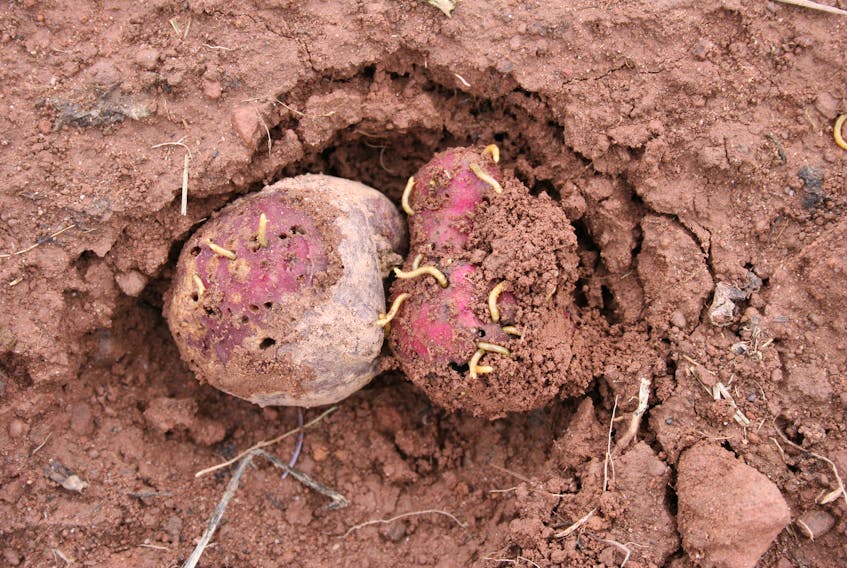PICTOU, N.S. — They’re small, hard to kill and grubby little buggers that are causing big problems for some farmers.
The wireworm is making a comeback in Nova Scotia.
“Last year we lost almost our entire onion crop to wireworm,” said Michael Coolican of Small Holdings Farm in Pictou.
“It was our first season putting plants in the ground and we started seeing some of the seedling plants dying. When we went and looked closer, you’d see the wireworm’s butt wriggling out of the base of the stem just at soil level.”
Wireworms are born underground where they stay for years before emerging in the summer as mature click beetles.
These baby-click beetles are not picky eaters. They dine on crops including, but not limited to, potatoes, oats, wheat, barley, corn, carrots, cabbage, clover, rutabagas, lettuce, onions, peas parsnips and beans. Since they remain as larva for up to five years a single field can be home to different generations of wireworms.
Know before you grow
“Usually it starts in one really small location where the eggs were laid,” said Christine Noronha an Agriculture research scientist in Prince Edward Island who has been monitoring the wireworm in Atlantic Canada. “Slowly, over the years, they spread and spread and suddenly you see it in your entire field.”
Again, wireworms are not picky. In the absence of a planted crop wireworms can still eat the roots of whatever they can find.
“A field that has been uncultivated for years can have wireworms built up because there’s lots of food,” said Noronha. “Usually I find when farmers till, that they’ll go and plant something right away and then they’ll have a huge problem.”
Noronha’s best advice for dealing with wireworms is to know before you grow.
“First you have to identify if you actually have some,” she said.
Digging a 15-cm hole in the ground and baiting it with carrot or potato chunks attracts wireworms that may be in the ground.
“Cover it up and go back give days later, take the bait and look at the soil to see if there are any wireworms,” said Noronha. Back in Pictou County, Coolican said that these bait traps revealed the extent of their pest problem.

The best times to lay these bait traps are in early spring and fall when soil temperature is around 10 degrees.
“If you go later, then the wireworms have already gone into the ground. The time is critical.”
Since wireworms stay in the ground for so long, and because each mature click beetle can lay up to 200 eggs, Noronha recommends that growers start to take action if there are between one and two worms per-trap.
Coolican was finding a lot more than that.
“For probably a month or two we’d pull the traps up every day and find, depending on the trap, between seven or eight wireworms with their wriggling butts on the outside,” said Coolican. “That’s when we realized not only do we have wireworms, but we have a wireworm problem.”
Taking action
There are over 800 species of wireworm, but according to Agiculture and Agri-Food Canada only a few species pose a serious threat to peoples’ crops.
One of these species of is called Agriotes Sputator, an invasive species from Europe which will feed on seeds in the springtime and on root vegetables in the fall.
Fortunately, researchers like Noronha have found that this worm’s appetite can be used against it by planting things that it just can’t stomach.
“Mustard has a chemical in its roots that is toxic to the insect that feeds on it,” said Noronha. “It decreases the population because they’re feeding on it and they don’ have anything else to eat.”
For new farmers who have identified a wireworm problem, Noronha recommends planting mustard and buckwheat, which is not toxic but also doesn’t have enough nutritional value to sustain a wireworm population. Together these crops act both as a cover-crop and a wireworm killer.
At Small Holdings Farm, Coolican said that the mustard and buckwheat are now in the area of their farm where they experienced crop loss. Now they’re monitoring the progress.
“We’ve allowed for the cover cropping in our rotations to be mustard or buckwheat,” said Coolican. “the thing we’re not clear at the moment is what’s going to happen next year. Will we have beaten them back or will we have the same story happen.”









